The amazing scents lavender produces would have to be one of, if not the best, aromas to hit your nose during their blooming period. Thankfully it’s not a very difficult plant to grow.
However, it does have some very specific light requirements that could come as a surprise.
So, can lavender grow in the shade?
Well. Lavender demands full sun without any form of shading that can hinder its growth. That’s why ideally they can’t grow in the shade. However, a slight amount of shade for very short periods during the afternoon can help them to recover from their ray requirements.
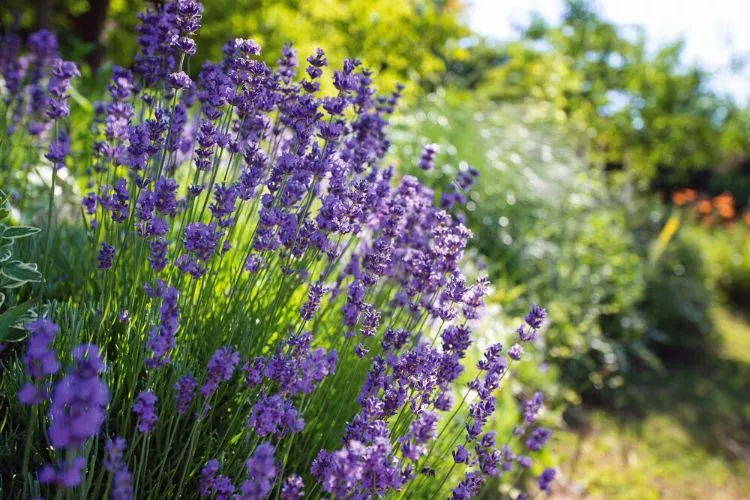
In this article, we’ll go through all the ins and outs of growing lavender in the shade and how to ensure they are still receiving all the sun they need to help them thrive.
Table of Contents
Can lavender grow in the shade?
It’s safe to say that the humble lavender plant worships the sun and doesn’t fare too well when too much shade is present.
Understanding the sun and shade requirements of lavender can be achieved by simply tracing them back to their origin. These amazing smelling bushes were discovered over 2500 years ago in parts of the Mediterranean, Middle East, and India.
These regions are notoriously hot and dry. They grew and still grow in abundance there, spreading like wildfire under the sun-kissed conditions.
Therefore, lavender has built up quite a resistance to drought-like conditions. That’s not to say that they don’t appreciate water every 2-3 days to promote growth.
Lavender varieties that can tolerate shade
When planning out your growing area, it’s not always possible to have optimal amounts of sun. Let’s face it; sometimes, we just deal with what we have.
So, if you want to grow lavender but cannot provide them with the amount of sun they need, then a few species are more willing to tolerate the lack of sunshine. These include:
English lavender (Lavandula angustifolia)
The English Lavender variety is best known for its oils. They are the most sought after due to their potency.
Like most lavender species, they still require a heap of sun, but they can have the occasional shady cover without hindering too much growth and spread.
Besides their oils, English lavender can be used as effective garden borders in cooking and creating amazingly fragrant potpourri.
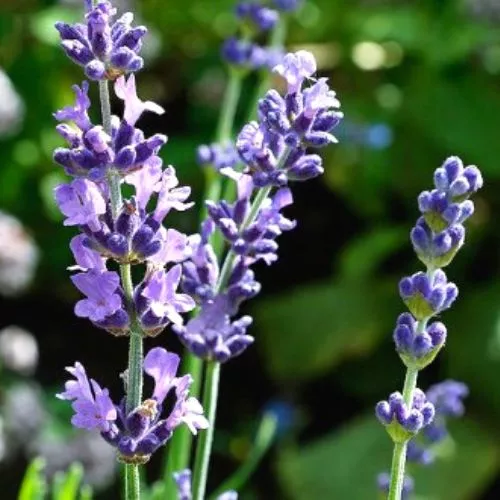
French lavender (Lavandula stoechas)

French Lavender is grown for its slightly different look. It has a silvery tinge that steps away from the traditional solid purples, pinks, and violets.
This species thrives in full sun but doesn’t mind a bit of shading due to its slightly more tender characteristics. It is also a magnet for many bee and butterfly species.
It’s a great option for hedging and containers, but it can also spread like crazy if poorly maintained.
Spanish lavender (Lavandula x intermedia)
This variant is a hybrid between English Lavender and a Portuguese species (Lavandula Latifolia). It’s usually grown for its high oil production.
However, the quality isn’t as good as the English lavenders. Full sun is a must for the Spanish lavender. However, they can cope with some light shading if necessary.
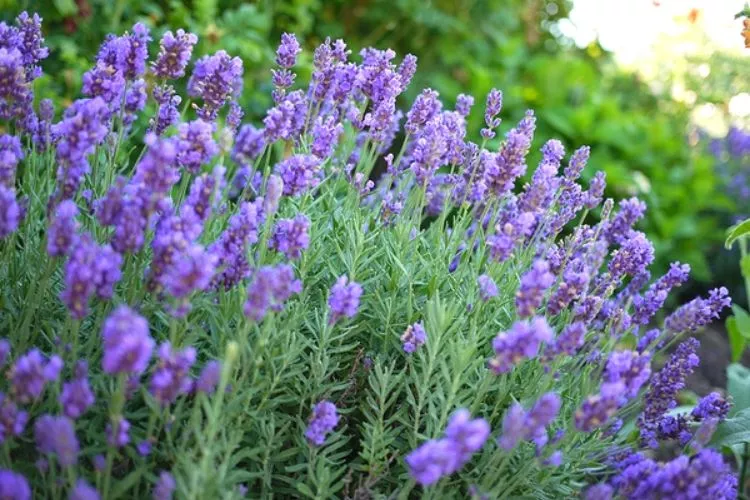
How to care for lavender in the shade?
It’s not always possible to grow your lavender exactly where you want it; let’s face it, everyone’s growing area is unique. It may receive a decent amount of sun but just not enough as it should.
If this is the case, then there are a few actions that you can take to improve its chance of surviving and thriving. Keep in mind that these needs may alter slightly depending on the species of lavender. These conditions include:
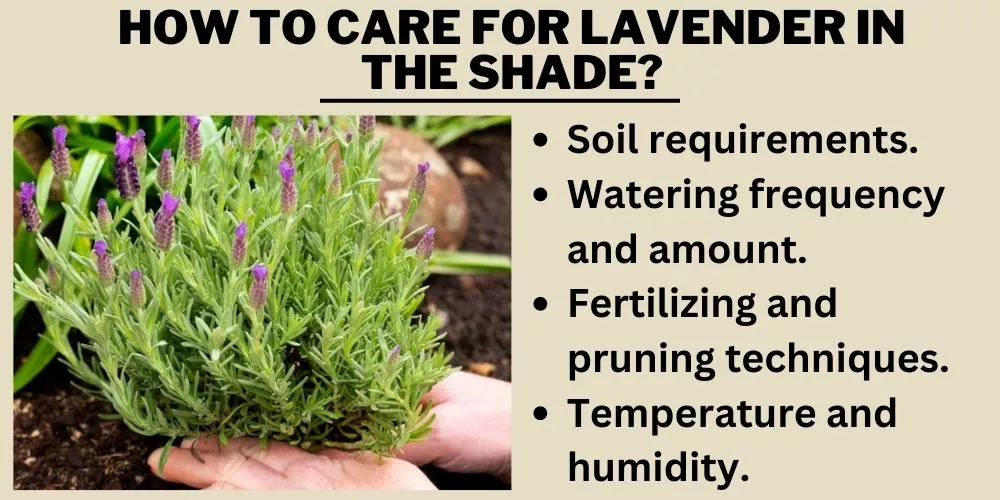
Soil requirements
Most Lavender species require soil that offers exceptional drainage and adequate aeration. This will allow the roots to establish themselves and anchor the weight of these often dense growing bushy plants. It’s ok to use a standard potting mix.
However, blending in some coarse materials such as builders’ sand, pumice, wood chips, bark mulch, clay pebbles, etc is recommended. This help to restrict the soil from clumping and give any moisture an easy pathway out and away, including humidity runoff.
Additionally, the soil pH should be almost neutral and range between 6.5-7.5 to allow optimal growth and longevity. Slightly acidic to slightly alkaline can still produce great results.
Watering frequency and amount
If you have just planted your lavender in the ground, then it will need water every 3 days or so (twice a week) to allow them to establish its root system. This frequency can be used for the first 2-3 months, depending on the soil condition and how well the plant can adapt to its new surroundings.
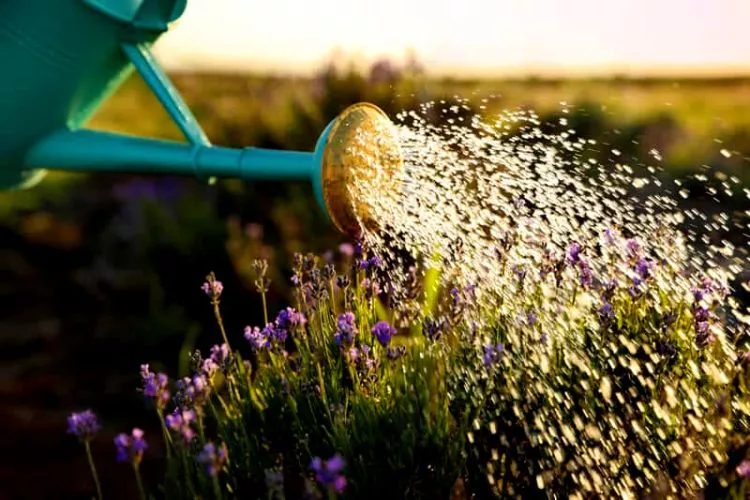
Be a bit generous with the amount they receive during this time. By this stage, they should have matured. You can then scale the frequency back to every 2-3 weeks until the buds have completely formed. Aim to give them a light sprinkle and avoid flooding them at all costs.
Lavenders do not appreciate over watering as it can easily lead to root rot. The leaves will turn yellow if they take in too much moisture. If you notice this occurring, allow them to dry out before more water is administered completely.
Potted lavender only needs to be watered once a week in its initial growing season. This can last for 2 years. Once established, this frequency can be scaled back to once every 2 weeks. Always check on potted lavender, as they can dry out much faster than those planted in the ground.
If you’re unsure if they need water, simply stick your finger 2-3 inches into the soil. You should give them a light sprinkle if it comes out dry. Otherwise, wait until it dries out first.
Fertilizing and pruning techniques
Lavender doesn’t require much in the way of manual feeding. Fertilizing them can work against you if you want amazing blooms.
Any excess nitrogen that fertilizer contains will force foliage growth instead of buds. Meaning you’ll have a gangly, green lavender bush with minimal flowers.
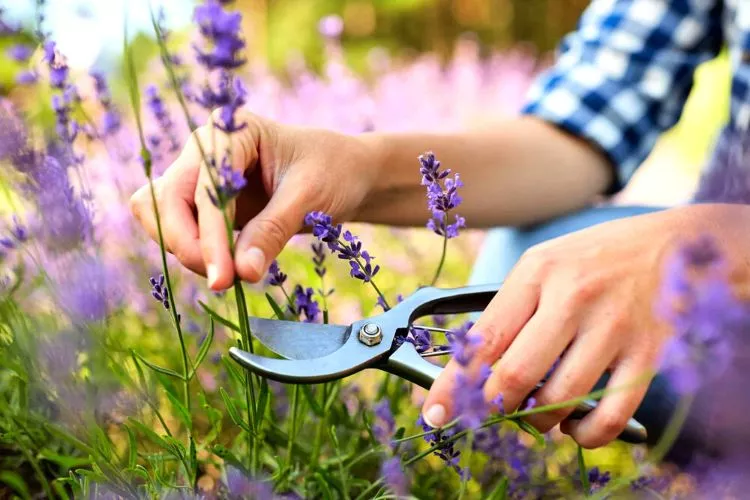
When these purple wonders are left to fend for themselves, they can grow wild. Furthermore, they can become quite woody and unattractive. The best way to maintain them is by keeping them compact and uniform. Aim to prune them late in the summer once they have finished flowering.
Remove around ⅓ of the outside of the plant and remove any spent flower stalks. Make sure that any pruning is completed with enough time for them to recover before any frost sets in. They will be healed and strong enough to withstand these conditions.
Temperature and humidity
Lavender thrives best in the mild Mediterranean climate, which receives temperatures between 65°-85°F (18-29.)°C). These areas also have minimal humidity. Therefore, dry and warm climates suit them best. However, this isn’t always possible in reality, so at least planting them somewhere with the full sun will give them a fighting chance.
Tips for successful lavender growth in the shade
Lavender loves being showered with an abundance of sunshine. Unfortunately, though, with the weather and the characteristics of many planting areas, they just aren’t able to receive as much as they would like.
There are a few really handy actions to consider to help mitigate the lack of the sun’s rays when growing your lavender.
Let’s have a look at these actionable tips:
- Location: If you can help it, plan out your garden before you begin. Choose an area in the middle of the open and not surrounded by anything that causes shading. If planting next to other foliage, ensure that they mature at a lower height and aren’t planted too close. The latter will assist with any humidity problems. Additionally, plant somewhere that contains a windbreak or some respite shelter to help counteract any strong winds and/or heavy rains.
- Consider Potting: As much joy it is to see lavender spreading far and wide on the ground, it may be a better option to plant them in containers. Especially if they are located somewhere where they cannot receive the sun’s rays. Containers are much easier to move around if need be.
- Makeshift Light: Consider adding an artificial source if your lavender is growing somewhere that could do with some more light. Extra light doesn’t necessarily need to come from lamps. Consider using reflective surfaces such as gazing balls, ponds, white painted walls, etc., to help distribute the lighte more easily. You can even try to prune back any canopy cover or other sunblocking tree/bush/plant limbs to increase the light in an area.
Frequently Asked Questions (FAQs)
Does lavender like morning or afternoon sun?
Lavender plants thrive best with at least 6-8 hours of direct sun daily. The morning sun is optimal as it doesn’t generally scorch the flowers. The bite of the afternoon sun can cause some damage in extreme climates.
How many hours of sun does lavender need?
Lavender generally needs a minimum of 6-8 hours of direct sun daily.
What happens if lavender doesn’t get enough sun?
They will simply not grow as efficiently. Lavender relies on its abundance of the sun to promote photosynthesis. Without it, they cannot convert any usable energy. As a result, the number of flowers will significantly decrease, the growth rate will decrease, and they will eventually die.
Which lavender is best in the shade?
Most species of lavender need a ton of sun to thrive. However, there is a small handful that requires slightly less and still produces some amazing aromas and impressive blooms. These include English lavender (Lavandula angustifolia), French lavender (Lavandula stoechas), and Spanish lavender (Lavandula x intermedia)
Where should I not plant lavender?
It’s not recommended to plant lavender near plants that require shade to thrive. Due to their need for adequate aeration and drainage within their soil, plants like impatiens, hosta, camellias, and fuschia are bad ideas. Unlike lavender, these types aren’t drought resistant, requiring a fair amount of water. If they are grown next to lavender, the chances of root rot occurring will greatly increase.
Conclusion:
As we have just discovered, lavender loves the sun. However, planting them somewhere that enables them to receive the required amount is not always possible. The best way to mitigate this problem is to plant them in areas that aren’t shaded by other plants or trees.
Additionally, it may be worth having a look into using some species that require less shade. Everyone does the garden they desire in a garden that isn’t perfect! We hope that this guide has been helpful.
You can read about similar topics here on our website. Check back again soon for more.


